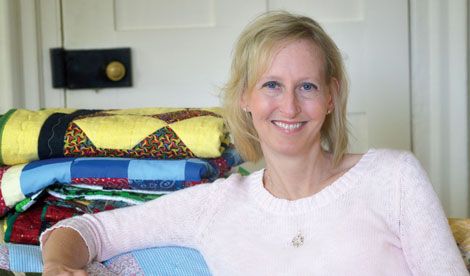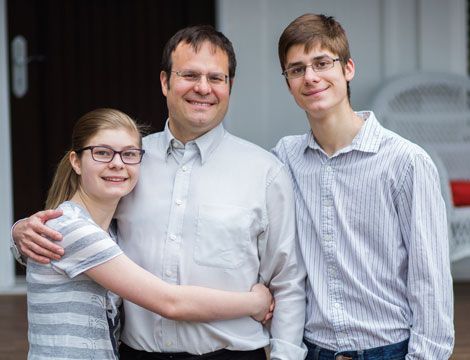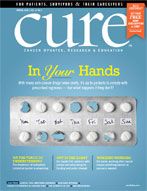Publication
Article
CURE
Working Wonders: Changing Careers After Cancer
Author(s):
For some, working after cancer means switching careers to pursue a passion.
For Sue Tonry, it took a single phone call in January 2009 to unravel more than a decade of corporate climbing in the demanding and high-stakes world of finance.
Her blood work, and now a doctor, were confirming what her body had been trying to tell her for months.
“I thought I was the healthiest person I knew, until I wasn’t,” she says. “I thought it was Lyme disease or mono. I never thought it was a blood cancer.”
An acute myeloid leukemia diagnosis would immediately land a then 39-year-old Tonry in a New Brunswick, N.J., hospital for what physicians anticipated would be a three-day stay.
“I told my boss I’d be back by Friday; I never came back,” Tonry says. “That hospital stay was a 32-day visit. They started me on chemo that night, and it was 24 hours a day. I was scared, and it was very surreal.”
A workaholic, Tonry converted her temporary sterilized digs into a pseudo office. There, she remotely scrutinized hospitals’ financial records and gave investors a bedside assurance of bond repayments on behalf of a statewide authority in health care facility financing.
“I actually brought my laptop and I worked in my hospital bed during chemo,” she says. Even as she underwent more treatment over the following months, “I thought I’d be back to work by December.”
After some time to think, though, Tonry went in an entirely different direction, starting a nonprofit quilting business aimed at providing comfort to patients like herself.
“I feel like I got sick, and it was God’s way of saying, ‘You haven’t been listening. I’m not punishing you. You can have what you want in your life,’” Tonry says. “Once I got away from having to work, I saw that there were other opportunities.”
It’s a dynamic that Rebecca V. Nellis, chief mission officer of Cancer and Careers — the only cancer organization whose mission is focused on work — sees often.
“The cancer experience for some is eye-opening, and there’s a drive for more meaning in their work or flexibility in their work,” she says. “In broad strokes, we’re seeing more people shifting careers.”
Sue Tonry

After cancer, SUE TONRY left a job in finance to start a nonprofit that makes quilts for patients. PHOTO BY ROBIN RESCH
Pursuing a Passion
While many drop out of the workforce after a cancer diagnosis, most end up returning. According to a 2005 report titled “Cancer Survivors at Work: A Generation of Progress,” between 62 and 84 percent of those who’ve had cancer end up returning to work.
Whether they wind up going back to their existing jobs or starting new ones depends on several factors.
“For some people, it’s determined by what their treatment is necessitating and the reality of what they can do,” Nellis cautions. “There are always many things that people going through cancer treatment need to consider and balance when it comes to supporting themselves, their families and their recovery.”
Some leave or switch jobs due to cognitive dysfunction, fatigue, neuropathy, lymphedema, time-consuming doctor’s appointments and concern about contracting colds or other illnesses while immunosuppressed. On the flip side of the coin, other survivors cite health insurance and income as reasons for sticking with their original jobs.
But beyond physical and financial concerns are matters of the spirit. Cancer, with all of its looming implications, has a unique way of sparking self-examination and igniting long-term change, and that motivates some to find new career paths.
I Don’t Know What I Want, But I Know It’s Not This: A Step-By-Step Guide To Finding Gratifying Work
“With cancer, you realize meaning is of the utmost importance,” says Julie Jansen, a career coach with Cancer and Careers and author of . “You can define meaning in a number of ways. But for people with cancer, it often means making a difference for other people.”
Nellis has primarily witnessed cancer become a catalyst for these transitions in middle-aged females, who tend to veer toward more mission-based work. So it’s not entirely surprising that Tonry’s story would take on a similar shape.
Seeing marked improvements after her first round of chemo, Tonry enrolled in quilting classes with one goal in sight: stitching her way to 40 quilts by her 40th birthday. More and more, she consumed herself with patterns, pins, patchwork and seams. They brought with them solace and strength. But when it came time for Tonry to distribute the finished products to patients at her hospital, yet again, a physician with a long face delivered somber news.
“My doctor came out with my labs and said, ‘How quickly can your husband get here?’” Tonry recalls.
Even after a successful bone marrow transplant, doctors dealt Tonry yet another major blow, discovering a leukemic mass on her spine and leukemia in her spinal column. She underwent radiation, but then hospice was called in, last rights were administered and Tonry was instructed to say her goodbyes.
“Each of my kids spent the night in bed with me, and I was ready to go,” she says.
Short of declaring a miracle, doctors still can’t fully explain how Tonry recovered — but, slowly, she did.
“When I didn’t die, my work called me up,” she says. “They were waiting. But I told them, ‘I can’t. I don’t even know if I’m going to be alive next week. I need to spend time with my kids.’”
Even as she took time off from work, somewhere deep down, she knew a revival was on its way.
It happened when Tonry veered into uncharted territory, turning her passion, Quilts for Comfort, into a nonprofit organization. Since founding Quilts for Comfort, Tonry and her volunteers have churned out hundreds of homespun pieces to children and adults waging a fight against blood cancer.
“I wanted to focus on those people who were isolated due to treatment,” she says.
Good Morning America
Some of these colorful artisanal gems have traveled as far away as Hawaii, and others into the hands of such well-known survivors as Robin Roberts from and Indianapolis Colts Head Coach Chuck Pagano.
“I thought, ‘I need something for my kids to remember me by,’” Tonry says. “I needed them to know Mom did something important. I wanted to leave them with that.”
Finding the Way
Like Tonry, other survivors of cancer may feel compelled to change careers. But not everyone will have her certainty about how to do it.
“They may have no idea how to actually change careers, or they’re not sure what their new career could be,” Jansen says. “There may be a need for additional education, which costs money, or it feels daunting or there’s a need to earn money as soon as possible. They also may not be ready physically, mentally or psychologically to do what it takes.”
To prepare for a career change, Jansen recommends a three-pronged approach.
> Conduct a self assessment:
After starting with an evaluation of their core values, job seekers should next examine their self-confidence, knowledge, motivation, work relationships, goals, skills and interests. If it’s clear that a current occupation is incapable of living up to those priorities and values, then it’s time to move on.
> Identify opportunities and obstacles:
Geography, experience and education levels, supply and demand, time consumption and economic realities can take on the roles of either pitfalls or positives. Weigh these factors carefully before taking the plunge into a particular industry or direction.
> Create an action plan:
Do the research, chat with seasoned professionals in a would-be field and troll the Internet for facts, blogs and other insider information. Most importantly, put it to paper, because writing down goals serves as both a reminder and the spark of motivation.
“It takes a minimum of six months to find a new job,” Jansen says. “You should first focus on the fundamentals: LinkedIn, networking and updating your resumé — and these don’t require a huge commitment.”
Something that does not necessarily need to be a focus, however, is cancer. Unless applicants will require special accommodations due to health issues, she says, they should not share a past cancer diagnosis with a prospective employer.
“I just recommend that (they don’t mention the cancer) if they are sure they are looking for full-time work (and) sure that they can handle the physical, emotional and psychological challenges,” she says.
All that said, Jansen adds, “Just don’t let any perceived limitations get in your way. If you’ve done your homework, if you have the skills, don’t let time, money, age, education, experience or obstacles get in your way. Don’t doubt yourself. With a positive attitude, you’ll make it happen. It will happen if you persist.”
The Toll on Caregivers
While cancer can have obvious repercussions for the careers of patients and survivors, it’s also difficult to deny the ripple effect it has on family, friends and caregivers. An experience with a loved one’s cancer can push a caregiver to change careers, too — and to grapple with a different set of issues along the way.
Talking Points
→ AFTER EXPERIENCING CANCER, some survivors find they are driven to follow a passion, seeking new careers that are meaningful and fulfilling.
→ MAKING SUCH A CHANGE can be difficult, but there are strategies that can help, such as conducting a self-assessment of skills, interests and the job market, writing an action plan and refusing to let perceived limitations get in the way.
It was an impromptu trip to a Duluth, Minn. hospital 13 years ago that steered caregiver Peter Kebbekus toward his unconventional ascent into medicine.
“My wife went to the emergency room for what she thought was an infection in her hip,” Kebbekus says of his once marathon-addicted better half, Annette. “Well, her white blood count wasn’t just up; it was 50 times the normal level.”
Within hours, doctors revealed the raw hand fate had dealt: acute myeloid leukemia.
“When it’s a bad diagnosis, even through the treatments and moving forward, you need to be cognizant of the numbers,” Kebbekus says. “There was a 50 percent chance she’d be alive in five years. We knew it was pretty dire.”
Four cycles of chemotherapy would prove fruitless for the 36-year-old, who seemed to have all the statistical cards stacked in her favor: tumor genetics, age and health. Despite those advantages and her valiant efforts, Annette succumbed to the disease in March 2003, leaving Kebbekus to rear their two children, ages 1 and 4.
While the journey was wrought with challenges, Annette’s harrowing battle with cancer ultimately drove Kebbekus, a then 36-year-old biochemistry professor, to enroll in medical school.
“I always thought maybe I’d go,” he says. “We talked about it when she was sick and things were not going well. I told her I still had that itch. I wouldn’t have done it if Annette had recovered, and if she had never been sick, it’s also something I wouldn’t have done.”
Much like surviving cancer, experts say that the death of a loved one underscores life’s fleeting nature, forcing family and friends to rethink their own priorities.
“People living with trauma, it does give them perspective, and sometimes they are fortunate enough to switch careers and become more productive human beings,” Jansen says.
As she suggests, Kebbekus found in his wife’s passing the motivation to take a chance and to discover more rewarding opportunities. The next four years were punctuated by helping hands, lengthy study sessions, endless medical rotations and mounting student debt.
“I can tell you what it was like to be a 41-year-old intern, showing up and hearing other staff members complain about 10 hours, and I’m here for 30,” he says. “It was not easy to be awake and functioning, and it took a lot of coffee and a lot of camaraderie to get through it. But I can’t imagine doing anything different.”
Naturally, pushback came from family members, who worried about the time Kebbekus spent away from his children.
“I don’t think anyone is second-guessing now,” he says.
Finding family support during a career change after cancer can come with its share of difficulties, Jansen points out.
“Families sometimes can be opposed to doing something different and may not understand,” she says. “Friends are different. Supportive friends are more forgiving.”
But perseverance through those issues can lead to career changes that work out well.
That was the case for Kebbekus, who came full circle during the later stages of his schooling when he settled on a specialty in oncology. Now working at Essentia Health in Duluth, he believes it was that darkest period in his life that brings out the best in him as a physician.
“I watched the person I loved most in the world waste away and die,” he says. “When I talk to a patient, I can be up-front and honest. I can also give them hope. I’m not sure anyone is born with that kind of empathy.”
Peter Kebbekus with his children Anna and Joseph

PETER KEBBEKUS, pictured with his children ANNA and JOSEPH, was inspired to become an oncologist after his wife, ANNETTE, died of leukemia.
PHOTO BY DEREK MONTGOMERY





